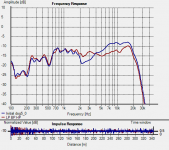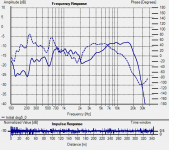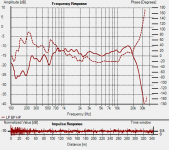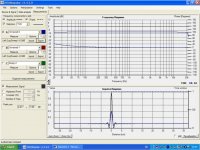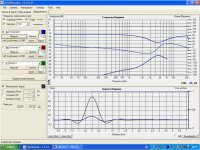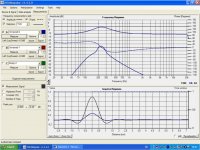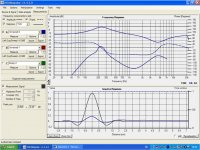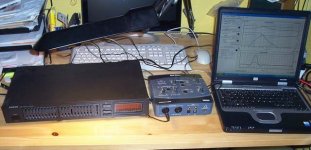I've got some very basic questions (which everyone else seems to already know the answers to). I've got an active 3 way system using a DCX2496 crossover. I also have a calibrated Dayton mic and an M-Audio USB Pre to connect between my mic and my laptop (via usb, obviously). I've go the mic on a tripod, and the preamp is recognized by my laptop and is powered up.
From a rank beginner standpoint, what do I do next? I figured maybe do the loop back calibration, but I'm not sure if I should hook something additional up to the M-Audio, or to my internal soundcard on the laptop, or what?
Like I said, pretty basic stuff, but I've read the manual (and this thread) a few times and I can't find an answer.
From a rank beginner standpoint, what do I do next? I figured maybe do the loop back calibration, but I'm not sure if I should hook something additional up to the M-Audio, or to my internal soundcard on the laptop, or what?
Like I said, pretty basic stuff, but I've read the manual (and this thread) a few times and I can't find an answer.
From a rank beginner standpoint, what do I do next? I figured maybe do the loop back calibration, but I'm not sure if I should hook something additional up to the M-Audio, or to my internal soundcard on the laptop, or what?
That's exactly what I attempted to do last night. The part that's throwing me off is whether or not I did the loopback with the M-audio in the best manner. For testing I'll be using the XLR in for my ECM8000 and the 1/4" out to feed my test amp. However, I did the loopback cal, with the headphone out and the stereo 3.5mm input. My results were pretty poor. Something like +/-6db over the audible range. From what I've seen posted by others, I'm thinking I'm going about it the wrong way.
Any advice by those in the know...?
Well I wouldn't use the headphone out on the mobile pre. I have my old one in front of me and looking at it I would use the outputs on the back and the XLR input without the phantom power turned on. You want to use the exact same outputs and inputs you plan on using.
That's what I was thinking... Looks like I'm buying a XLR connector tomorrow to make a cable.
I had seen some overly expensive speakers that use mechanical crimping throughout the crossover and wondered if it was somehow more reliable. And I do like to keep things as modular as possible.
I'm going with Dr. Geddes's opinion on this one as well. The mechanical connections don't seem like a bad idea. Honestly, I just assumed that board level components would be better off soldered. Learn something every day
I've got some very basic questions (which everyone else seems to already know the answers to). I've got an active 3 way system using a DCX2496 crossover. I also have a calibrated Dayton mic and an M-Audio USB Pre to connect between my mic and my laptop (via usb, obviously). I've go the mic on a tripod, and the preamp is recognized by my laptop and is powered up.
From a rank beginner standpoint, what do I do next? I figured maybe do the loop back calibration, but I'm not sure if I should hook something additional up to the M-Audio, or to my internal soundcard on the laptop, or what?
Like I said, pretty basic stuff, but I've read the manual (and this thread) a few times and I can't find an answer.
Hi, could someone give me hand with the questions above?
 Off topic posts about crimps and solder moved here:
Off topic posts about crimps and solder moved here:http://www.diyaudio.com/forums/equipment-tools/103677-solder-vs-crimp.html?highlight=solder
Well I wouldn't use the headphone out on the mobile pre. I have my old one in front of me and looking at it I would use the outputs on the back and the XLR input without the phantom power turned on. You want to use the exact same outputs and inputs you plan on using.
Well I did what was suggested, and it certainly cleared everything up somewhat, (once I removed my mic's cal file
So with all other fields default, I have the API set for MME, and the PCM-Amplitude set at 0.22, the log sweep gives me this result:
+/-6db over 31Hz to 21kHz
An externally hosted image should be here but it was not working when we last tested it.
Obviously the problem is at the bottom end. Am I doing something wrong...? I've seen other members state results of +/-3db or better.
TIA
Looks like some kind of high pass filter is active....
Amongst other things...
Your response made me doubt the default settings, so I went to tweak. Sure enough I managed to find some things that definitely effected my results.
The fade in was the "filter" we were seeing at the bottom end, (default 10msec). ...and it seems to me that the +/-6db variance is a result of the top end beyond 20kHz. I couldn't figure out how to remove that from the response, but I don't think there really is a need.
New attempt with "fade in" zeroed:
+/-6db 10Hz to 21218Hz

I don't think I'll get much better than that through the audible range.

If the forum is accepting votes for a possible SW wiki. Please add one to the yay column...
What is your sound card ?
Can you post the picture of the "DAC-ADC loop back" and the "DAC-ADC loop back calibrated" plots?
M-Audio MobilePre USB
M-AUDIO - MobilePre USB - USB Bus-Powered Preamp and Audio Interface
I accepted the "fade in removed" loopback calibration test, and the resulting calibrated plot is straight as a nail. I'd could post it, but it is flat as board, and my laptop isn't online
Do you see something off with the second set of plots I posted...?
No, I think you solved your problem...Do you see something off with the second set of plots I posted...?
Nice software Thanks
Ask,
Thank you for your contribution. This package is so far the best I have used and has provided the best results in my limited abilities.
I still have alot to learn with this software, like how to measure THD but it has made a significant improvement in my system already.
Attached is the before and after of my 3-way I am designing now. My mic is not calibrated yet so I am careful not base too much on the measurements except for the obvious.
If anybody has any thoughts on the curves I am open to them...
Ask,
Thank you for your contribution. This package is so far the best I have used and has provided the best results in my limited abilities.
I still have alot to learn with this software, like how to measure THD but it has made a significant improvement in my system already.
Attached is the before and after of my 3-way I am designing now. My mic is not calibrated yet so I am careful not base too much on the measurements except for the obvious.
If anybody has any thoughts on the curves I am open to them...
Attachments
Quick question - I have a Dayton mic with a calibration file, and it "seems" as though it imported OK, but I have doubts.
When I check or uncheck the calibration file it has absolutely no effect on the data I see on the measurement page - shouldn't I see the values adjust, depending on if I have the calibration file checked, or not?
I notice it was looking for a .cal file when I went to import it, but the only files I have on my disc are .FRD files. Maybe there's an incompatibility issue?
When I check or uncheck the calibration file it has absolutely no effect on the data I see on the measurement page - shouldn't I see the values adjust, depending on if I have the calibration file checked, or not?
I notice it was looking for a .cal file when I went to import it, but the only files I have on my disc are .FRD files. Maybe there's an incompatibility issue?
Ask asked me, at the recent DIYAudio event in Denmark, to measure how 'bad' a graphic equaliser really is. Here are the results:
First picture is all pots at 0
Second picture is 250Hz pushed to +10dB
Third picture is 4kHz lowered to -10dB
First picture is all pots at 0
Second picture is 250Hz pushed to +10dB
Third picture is 4kHz lowered to -10dB
Attachments
...And finally 250Hz at +10dB and 4kHz at -10dB at the same time.
Second picture is the setup.
The equalizer is a Onkyo EQ-25, modified with paralleling elctrolytics with MKT.
Thanks to Ask for a super-easy measuring program.
Second picture is the setup.
The equalizer is a Onkyo EQ-25, modified with paralleling elctrolytics with MKT.
Thanks to Ask for a super-easy measuring program.
Attachments
Please notice taht I changed the scale for the impulse from the first measurement to the rest.
Please also notice that in neutral (all 0) THD measurement says "OK:NA".
....An I think that even in use, the phase-angles are not too bad, but ofcourse the THD rises quite a bit.
Please also notice that in neutral (all 0) THD measurement says "OK:NA".
....An I think that even in use, the phase-angles are not too bad, but ofcourse the THD rises quite a bit.
- Home
- Design & Build
- Software Tools
- HOLMImpulse: Measurements in practice
